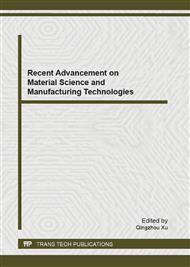[1]
N.R.L. Pearce, F.J. Guild, J. Summerscales, The use of automated image analysis for the investigation of fabric architecture on the processing and properties of fibre-reinforced composites produced by RTM, Composites Part A. 29 (1998) 829-837.
DOI: 10.1016/s1359-835x(98)00065-7
Google Scholar
[2]
T. Uozumi, A. Kito, T. Yanamtoto, CFRP using braided performs/RTM process for aircraft applications, Adv. Compos. Mater. 14 (2005) 365-383.
DOI: 10.1163/156855105774470366
Google Scholar
[3]
C. Soutis, Carbon fiber reinforced plastics in aircraft construction, Mat. Sci. Eng. A. 412 (2005) 171-176.
DOI: 10.1016/j.msea.2005.08.064
Google Scholar
[4]
J. Verrey, M.D. Wakeman, V. Michaud, et al, Manufacturing cost comparison of thermoplastic and thermoset RTM for an automotive floor pan, Composites Part A. 37 (2006) 9-22.
DOI: 10.1016/j.compositesa.2005.05.048
Google Scholar
[5]
B. Gourichon, C. Binetruy, P. Krawczak, A new numerical procedure to predict dynamic void content in liquid composite molding, Composites Part A. 37 (2006) 1961-1969.
DOI: 10.1016/j.compositesa.2005.12.017
Google Scholar
[6]
S.B. He, G.Z. Liang, H.X. Yan, et al, High performance toughened cyanate eater resin with low injection temperature for RTM process, Polym. Advan. Technol. 20 (2009) 143-146.
DOI: 10.1002/pat.1291
Google Scholar
[7]
E. Schmachtenberg, J.H. Schulte, J. Töpker, Application of ultrasonics for the process control of Resin Transfer Moulding (RTM), Polym. Test. 24 (2005) 330-338.
DOI: 10.1016/j.polymertesting.2004.11.002
Google Scholar
[8]
S.L. Jiang, C. Zhang, B. Wang, Optimum arrangement of gate and vent locations for RTM process design, Composites Part A. 33 (2002) 471-481.
DOI: 10.1016/s1359-835x(01)00146-4
Google Scholar
[9]
Y. Wang, S.M. Grove, Modelling microscopic flow in woven fabric reinforcements and its application in dual-scale resin infusion modeling, Composites Part A. 39 (2008) 843-855.
DOI: 10.1016/j.compositesa.2008.01.014
Google Scholar
[10]
N. Pearce, F. Guild, J. Summerscales, A study of the effects of convergent flow fronts on the properties of fibre reinforced composites produced by RTM, Composites Part A. 29 (1998) 141-152.
DOI: 10.1016/s1359-835x(97)00041-9
Google Scholar
[11]
J. Merotte, P. Simacek, S.G. Advani, Flow analysis during compression of partially impregnated fiber preform under controlled force, Compos. Sci. Technol. 70 (2010) 725-733.
DOI: 10.1016/j.compscitech.2010.01.002
Google Scholar
[12]
J. Varna, R. Joffe, L.A. Berglund, et al, Effect of voids on failure mechanisms in RTM laminates, Compos. Sci. Technol. 52 (1995) 241-249.
DOI: 10.1016/0266-3538(95)00024-0
Google Scholar


